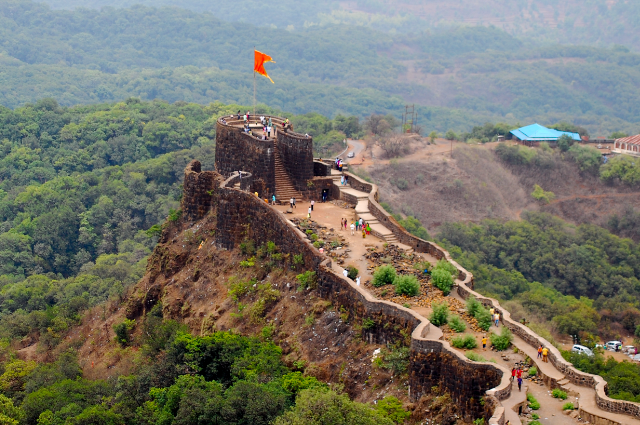In a monumental decision that resounded across the globe, the 47th Session of the UNESCO World Heritage Committee officially inscribed India's "Maratha Military Landscapes" onto its prestigious World Heritage List. This landmark achievement, setting India's 44th property to earn such esteemed recognition stands as a testament to the nation's enduring cultural legacy. It showcases a vibrant tapestry of architectural brilliance, profound regional identity and an unbroken thread of historical continuity that has shaped India for centuries.
Celebrating a Strategic Vision
The announcement sparked widespread joy with Prime Minister Shri Narendra Modi, Minister of Culture Shri Gajendra Singh Shekhawat and Chief Minister of Maharashtra Shri Devendra Fadnavis all extending their heartfelt congratulations to the people of India. This celebrated network comprises twelve difficult forts, crossing the 17th to 19th centuries CE, which collectively epitomise the Maratha Empire's extraordinary strategic military far-sightedness and remarkable architectural imagination.
The journey to this global recognition was a rigorous one. The proposal for the Maratha Military Landscapes was initially submitted to the World Heritage Committee in January 2024. What followed was an intensive eighteen-month process that was marked by numerous technical meetings with advisory bodies and a crucial site visit by ICOMOS (International Council on Monuments and Sites) missions to meticulously review the nominated locations. The peak of this diligent effort arrived today evening at UNESCO Headquarters in Paris, where the World Heritage Committee made its historic decision.
A Diverse and Ingenious Network of Forts
The selected sites that are spread across the states of Maharashtra and Tamil Nadu offer a compelling illustration of the Marathas' sophisticated understanding of geography and strategic defense planning. In Maharashtra, the inscribed forts include Salher, Shivneri, Lohgad, Khanderi, Raigad, Rajgad, Pratapgad, Suvarnadurg, Panhala, Vijaydurg, and Sindhudurg. Adding to this impressive roster is the significant Gingee Fort in Tamil Nadu.
These architectural marvels are strategically positioned across an array of diverse terrains, ranging from tough coastal outposts to dense hilltop strongholds. This geographical diversity underscores their innovative adaptation of fortification traditions in India, forming a cohesive military landscape that speaks volumes about the Maratha's advanced defensive strategies.
The forts showcase remarkable variation in their construction and location, each uniquely suited to its environment:
- Hill Forts: Salher, Shivneri, Lohgad, Raigad, Rajgad, and Gingee, all balanced on hilly terrains.
- Hill-Forest Fort: Pratapgad, cleverly integrated within dense wooded areas.
- Hill-Plateau Fort: Panhala, situated on a plateaued hill by offering a commanding view.
- Coastal Fort: Vijaydurg, strategically positioned along the shoreline for maritime defense.
- Island Forts: Khanderi, Suvarnadurg, and Sindhudurg, entirely surrounded by the sea, serve as crucial naval strongholds.
During the Committee Meeting, an overwhelming 18 out of 20 State Parties expressed their support for India's proposal. The ensuing discussion lasted a focused 59 minutes, after which the positive recommendations from these 18 State Parties led to universal applause. All member states along with UNESCO, the World Heritage Centre and the advisory bodies of UNESCO (ICOMOS and IUCN), extended their congratulations to the Indian delegation for this momentous achievement.
Preserving Outstanding Universal Values
The "Maratha Military Landscape of India" was nominated under UNESCO's criteria (iv) and (vi). These criteria acknowledge the sites' exceptional testimony to a living cultural tradition, their profound architectural, technological significance, and their deep-seated associations with pivotal historic events and enduring traditions.
The very essence of including such heritage sites on UNESCO's list is to safeguard and promote shared global heritage, specifically based on the Outstanding Universal Values (OUVs) found in cultural, natural, and mixed properties across 196 countries. India, demonstrating its commitment to this noble cause has been an active member of the World Heritage Committee from 2021-2025.
India's Growing Global Footprint in Heritage
This global recognition serves as compelling evidence of "New India's" unwavering dedication to showcasing "Bharat's" rich heritage on the world stage. It also significantly underscores the diligent efforts of the Archaeological Survey of India (ASI) and the Maharashtra government in their tireless work to preserve these invaluable historic treasures for future generations.
This latest inscription follows closely on the heels of another significant achievement, last year, the Moidams of Charaideo, Assam, were inscribed on the World Heritage List at the 46th Session of the World Heritage Committee, which was notably held in New Delhi.
India's commitment to heritage preservation is evident in its standing as the 6th globally and 2nd in the Asia Pacific Region for the highest number of World Heritage Sites. Currently, 196 nations have ratified the World Heritage Convention of 1972, which demonstrates a global commitment to this cause. Furthermore, India boasts 62 sites on its Tentative list, a crucial pre-requisite for any site aspiring to be considered for World Heritage status in the future. Annually, each State Party is permitted to propose only one site for consideration by the World Heritage Committee for inscription on the World Heritage List.
On behalf of the Government of India, the Archaeological Survey of India (ASI) proudly serves as the nodal agency for all matters related to World Heritage within the country, directing India's efforts to preserve and promote its rich historical and cultural tapestry.
. . .
References:

